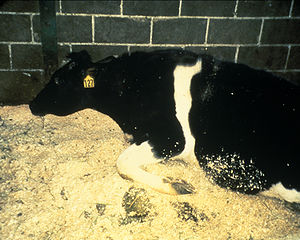Bovine Spongiform Encephalopathy
| Bovine spongiform encephalopathy | |
|---|---|
 |
|
| A cow with BSE: Infected animals lose the ability to stand. | |
| Classification and external resources |
Bovine spongiform encephalopathy (BSE), commonly known as mad cow disease, is a transmissible spongiform encephalopathy and fatal neurodegenerative disease in cattle that causes a spongiform degeneration of the brain and spinal cord. BSE has a long incubation period, of 2.5 to 5 years, usually affecting adult cattle at a peak age onset of four to five years. BSE is caused by a misfolded protein—a prion. In the United Kingdom, the country worst affected by an epidemic in 1986–1998, more than 180,000 cattle were infected and 4.4 million slaughtered during the eradication program.
The disease may be most frequently transmitted to humans by eating food contaminated with the brain, spinal cord, or digestive tract of infected carcasses. However, the infectious agent, although most highly concentrated in nervous tissue, can be found in virtually all tissues throughout the body, including blood. When it has been transmitted to humans, it is known as new variant Creutzfeldt–Jakob disease (vCJD or nvCJD), and by June 2014 it had killed 177 people in the United Kingdom, and 52 elsewhere, primarily in western Europe in countries supplied with beef or beef products from the UK. Between 460,000 and 482,000 BSE-infected animals had entered the human food chain before controls on high-risk offal were introduced in 1989.
A British and Irish inquiry into BSE concluded the epizootic was caused by cattle, which are normally herbivores, being fed the remains of other cattle in the form of meat and bone meal (MBM), a protein supplement in concentrated feeds. Since dairy calves are generally fed concentrated feed after they are weaned, they usually develop this disease more often than beef cattle
The cause of BSE may be from the contamination of MBM from sheep with scrapie that were processed in the same slaughterhouse. The epidemic was probably accelerated by the recycling of infected bovine tissues prior to the recognition of BSE. The origin of the disease itself remains unknown. The infectious agent is distinctive for the high temperatures at which it remains viable, over 600 °C (1,112 °F). This contributed to the spread of the disease in the United Kingdom, which had reduced the temperatures used during its rendering process. Another contributory factor was the feeding of infected protein supplements to very young calves.
...
Wikipedia
